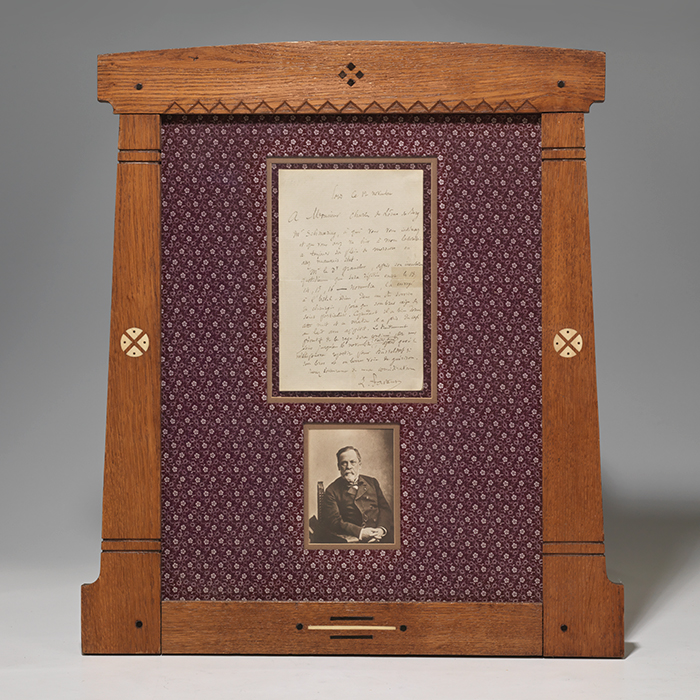
"THE 'PREVENTATIVE' TREATMENT FOR RABIES WILL BE CONTINUED BY ME": FASCINATING SIGNED AUTOGRAPH LETTER, CIRCA 1887, WRITTEN BY LOUIS PASTEUR TO A COLLEAGUE INTERESTED IN THE STATE OF A PATIENT RECEIVING RABIES TREATMENT AFTER BEING MAULED BY A RABID ANIMAL
PASTEUR, Louis. Autograph letter signed. Paris, circa 1887. Single sheet of paper, folded in half measuring 5-1/4 by 9 inches; p. 1; elaborately matted and framed with portrait, entire piece measures 19-3/4 by 22-1/4 inches. $12,500.
Fascinating autograph letter, circa 1887, written and signed by the "Father of Microbiology," Louis Pasteur, regarding the condition and prognosis of a severely bitten patient who was receiving Pasteur's experimental preventative rabies treatment, in an unusual inlaid Arts and Crafts Movement frame.
The letter (in translation from the original French) reads in full: "Paris, November 12. To Mr. Charles de Lome de Berg, Mr. Schnoering whom you are interested in and whom you have seen in my laboratory yesterday, still has the wound of the bite and is in rather poor condition. Dr. Grancher has sent him, after his daily inoculation which will be repeated on the 13, 14, 15 and 16 of November, to the Hotel-Dieu into one of the surgical departments, because his arm needs special care. He slept well this night and took this morning some coffee and milk with appetite. The 'preventative' treatment for rabies will be continued by me until November 16 at the Hotel-Dieu, and then the patient will be able to leave for Dusseldorf, if his arm is progressing on the way to recovery. Rest assured of my consideration. L. Pasteur."
This letter concerns pasteurization pioneer and acclaimed microbiologist Louis Pasteur's extensive experiments toward creating a rabies vaccine. "As the director of scientific studies at the Ecole Normale in Paris, Pasteur pursued his germ theory, which posited that germs attack the body from the outside. Proved right again, his work led to vaccinations being developed for many germ-borne diseases, including anthrax, tuberculosis, cholera and smallpox. It also led to further work on rabies, which was much more prevalent in Pasteur's time than it is today. He developed his rabies vaccine by growing the virus in rabbits, then drying the affected nerve tissue to weaken the virus" (Wired). In 1885, Pasteur had the opportunity to test his vaccine when a nine-year-old Alsatian boy, Joseph Meister, was bitten by a rabid dog. Pasteur was deeply disturbed by the idea of experimenting a child and knew he was using a different version of the vaccine than he used in his experiments with dogs. Nevertheless, Pasteur went forward. Meister survived, indicating the viability of a rabies vaccine. The result was that patients were sent from as far as America—imminently possible given rabies month-long incubation period—to receive treatment. Thus, the "Mr. Schnoering" mentioned would easily have been able to secure Pasteur's assistance at the Hotel-Dieu in Paris (one of Europe's oldest hospitals), despite living in Dusseldorf. While a very small number of his patients died, leading to some public objections to his work, the vast majority survived. "In 1888, the Pasteur Institute was opened, and although his vaccine was soon superseded by a chemically inactivated alternative, Pasteur himself is remembered, rightly or wrongly, as a revolutionary scientist and a careful experimentalist" (Offord, The Scientist).
Faint evidence of tape repair at middle of letter, faint fold crease. A most desirable letter, handsomely framed.